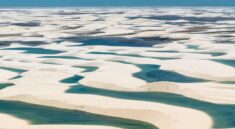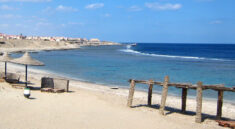Meradalir is a valley on the Reykjanes Peninsula in Iceland. It is located east of the Fagradalsfjall volcano and was formed by the volcano’s lava flows. The valley is about 10 kilometers long and 3 kilometers wide and is characterized by lava fields, craters, and fumaroles.
The Fagradalsfjall eruption began on March 19, 2021 and lasted until September 27, 2023. During this time, about 240 million cubic meters of lava flowed into the Meradalir valley. The lava flows created a new landscape with bizarre shapes and colors.
The Meradalir valley is a popular destination for tourists who want to experience the Fagradalsfjall eruption up close. There are several hiking trails that lead into the valley. The trail from road 427 to the crater of the volcano is about 10 kilometers long and takes about 4 hours.
The Fagradalsfjall eruption is one of the largest volcanic eruptions in Iceland since the 18th century. It has made the Meradalir valley a unique natural wonder.
Please note that the volcano is still active, so it is important to check the latest safety information before visiting the area.
How to get there
To visit the Meradalir volcanic system in Iceland, you’ll need to travel to the Reykjanes Peninsula. Here’s how to get there:
- Fly to Iceland: Start by booking a flight to Keflavík International Airport (KEF), which is the primary international airport serving Reykjavik and the Reykjanes Peninsula.
- Rent a Vehicle: After arriving at Keflavík International Airport, rent a vehicle (car or 4×4) if you haven’t already done so. Having a vehicle is the most convenient way to explore the Reykjanes Peninsula and reach Meradalir.
- Drive to the Reykjanes Peninsula:
- Exit the airport and head southwest toward the Reykjanes Peninsula.
- The Meradalir area is situated in the vicinity of the Fagradalsfjall volcano, which is located on the peninsula.
- Follow road signs and GPS directions to reach the area around the Fagradalsfjall volcano.
- Hiking to Meradalir: Once you reach the general vicinity of the Fagradalsfjall volcano, you may need to park your vehicle in designated areas. From there, you can follow hiking trails or paths to reach Meradalir. Be sure to check local information and trail conditions, as they may change based on volcanic activity.
- Safety Precautions: If you plan to visit the area around an active volcano like Fagradalsfjall, it’s crucial to prioritize safety. Be aware of any warnings or restrictions issued by local authorities, and follow their guidance. Respect any closed areas and be prepared for changing conditions, including potential gas emissions.
- Check for Updates: Before your trip, consult official sources such as the Icelandic Meteorological Office and local authorities for real-time updates on volcanic activity, safety recommendations, and any changes in access to the area.
Please note that volcanic activity can be unpredictable, and conditions can change rapidly. It’s essential to stay informed and follow safety guidelines when visiting volcanic sites in Iceland. Additionally, consider the time of year, weather conditions, and the readiness of the volcano for public access when planning your visit to Meradalir.
Things to do
When visiting the Meradalir volcanic system on the Reykjanes Peninsula in Iceland, there are several exciting and unique activities you can enjoy. Here are some things to do in the area:
- Witness the Eruption: The primary attraction in the Meradalir area is the volcanic eruption itself. Marvel at the spectacle of molten lava spewing from the crater and the dynamic, ever-changing landscape.
- Hiking and Exploration: Explore the surrounding volcanic terrain on foot. There may be hiking trails or paths that allow you to get closer to the eruption site while maintaining a safe distance.
- Photography: Capture the dramatic volcanic landscapes and the eruption’s fiery display. The ever-shifting lava flows and colors make for stunning photography opportunities.
- Educational Tours: Join guided tours or excursions led by knowledgeable guides who can provide insights into the geological processes at play and the history of the eruption.
- Geological Learning: Take the opportunity to learn about volcanic geology, lava formations, and the science behind volcanic eruptions.
- Northern Lights (Aurora Borealis): If you visit the area during the winter months and the eruption continues, you might have a unique opportunity to witness the Northern Lights against the backdrop of an active volcano.
- Safety Precautions: Ensure you follow safety guidelines and stay within designated areas. Volcanic eruptions can be hazardous, so it’s crucial to prioritize safety.
- Check for Updates: Before your visit, check for real-time updates on volcanic activity and access restrictions from reliable sources such as the Icelandic Meteorological Office and local authorities.
- Stargazing: The remote location and minimal light pollution make it an excellent spot for stargazing when the night sky is clear.
- Local Cuisine: After your visit, consider trying local Icelandic cuisine at nearby restaurants. This can be a great way to experience the local culture and flavors.
Remember that safety should be your top priority when visiting an active volcanic area. Always adhere to any safety recommendations or restrictions issued by authorities, and be prepared for changing conditions in the area around the eruption site.
Things not to forget
When visiting the Meradalir volcanic system on the Reykjanes Peninsula in Iceland, it’s essential to be well-prepared to ensure your safety and enjoyment. Here are some important things not to forget:
- Safety Gear: Depending on your proximity to the eruption, you may need safety gear such as a gas mask, helmet, and sturdy boots. Check local recommendations and requirements.
- Warm Clothing: Iceland’s weather can change rapidly, even in the summer. Dress in layers and bring warm clothing, including waterproof and windproof options.
- Water and Snacks: Carry an adequate supply of water and snacks for your visit, especially if you plan to spend an extended period in the area.
- Navigation Tools: Have reliable navigation tools, including a GPS device or smartphone with offline maps, to find your way to and from the volcanic site.
- Emergency Contact Information: Carry contact information for local emergency services, your embassy or consulate, and the nearest medical facilities.
- Travel Insurance: Ensure you have comprehensive travel insurance that covers activities and potential emergencies in Iceland.
- Photography Equipment: If you’re interested in photography, bring the necessary camera equipment, including spare batteries and memory cards.
- Safety Precautions: Follow safety guidelines and any restrictions imposed by local authorities. Be aware of the latest volcanic activity updates.
- Environmental Respect: Follow Leave No Trace principles by packing out all trash, staying on designated paths, and respecting local regulations.
- Cash: While credit cards are widely accepted in Iceland, it’s a good idea to carry some local currency for small purchases or in case of card payment issues.
- First-Aid Kit: Carry a basic first-aid kit with essentials such as bandages, antiseptic wipes, and any personal medications you may need.
- Local Information: Research and save the contact information for local tour operators, guides, and accommodations in the area.
- Language Assistance: If you’re not fluent in Icelandic, consider a language translation app or a pocket-sized phrasebook to facilitate communication.
- Respect for the Environment: Be mindful of the environment and wildlife. Stay within designated areas and avoid disturbing local ecosystems.
- Check for Updates: Before your visit, check for real-time updates on volcanic activity and safety recommendations from reliable sources.
Visiting an active volcanic area is an exciting but potentially hazardous endeavor. Prioritize safety, stay informed, and be prepared for changing conditions while enjoying the unique experience of witnessing a volcanic eruption in Iceland.
Best time to visit
The best time to visit the Meradalir volcanic system on the Reykjanes Peninsula in Iceland can depend on your preferences and what you hope to experience. Here are some considerations for different times of the year:
- Eruption Period: The best time to witness the volcanic eruption in Meradalir is when it is actively erupting. Eruptions can last for variable periods, and you should plan your visit during such periods if you want to witness the volcanic activity.
- Summer (June to August): This season offers milder weather and longer daylight hours, making it a popular time for visiting Iceland. It’s also a good time for hiking and outdoor activities. Keep in mind that the eruption may be ongoing or intermittent during this season.
- Fall (September to October): Fall brings colorful foliage to the Reykjanes Peninsula, providing a unique backdrop for your visit. The weather can still be relatively mild, and there may be fewer tourists compared to summer.
- Winter (November to February): Winter in Iceland offers the possibility of seeing the Northern Lights, especially if the eruption continues during these months. However, winter weather can be harsh, with shorter daylight hours and challenging conditions.
- Spring (March to May): Spring sees the landscape beginning to thaw and transition into a more vibrant state. It’s a good time for experiencing the changing seasons in Iceland.
- Safety First: Regardless of the season, prioritize safety. Check for real-time updates on volcanic activity, follow local recommendations, and adhere to safety guidelines. Always be prepared for changing conditions.
Keep in mind that the timing of volcanic eruptions is unpredictable, and the accessibility of the Meradalir area may change depending on volcanic activity and safety assessments. Before planning your visit, check the latest information and guidelines from official sources, such as the Icelandic Meteorological Office and local authorities.
Ultimately, the best time to visit Meradalir depends on your interest in witnessing the volcanic activity and your tolerance for different weather conditions.
Where is the Meradalir volcano?
The Meradalir volcano is located on the Reykjanes Peninsula in Iceland, about 50 kilometers south of the capital city, Reykjavik. It is part of the Fagradalsfjall volcanic system, which also includes the Fagradalsfjall volcano.
The Meradalir volcano is in a remote area, and there are no roads that lead directly to it. The only way to get to the volcano is to hike. There are two main hiking trails that lead to the volcano:
- The trail from road 427: This trail is about 10 kilometers long and takes about 4 hours to hike. It is the most popular trail, as it is the shortest and easiest way to get to the volcano.
- The trail from the Reykjadalir geothermal area: This trail is about 16 kilometers long and takes about 6 hours to hike. It is a more challenging hike, but it offers stunning views of the Reykjadalir geothermal area and the surrounding mountains.
If you are planning to hike to the Meradalir volcano, it is important to be well-prepared. The weather in Iceland can change quickly, so it is important to dress appropriately and bring plenty of food and water. It is also important to be aware of the risks associated with hiking in a volcanic area, such as falling rocks and toxic gases.
Please note that the Meradalir volcano is still active, so it is important to check the latest safety information before visiting the area.
Is Meradalir volcano still erupting?
No, the Meradalir volcano is not still erupting. The eruption ended on August 21, 2022.
The Meradalir eruption began on August 3, 2022 and lasted for 18 days. It was the third eruption in the Fagradalsfjall volcanic system since 2021.
The Meradalir eruption was relatively small, but it was still a spectacular sight. The lava flowed into the Meradalir valley, creating a new landscape of lava fields and craters. The eruption was also a valuable opportunity for scientists to study how volcanoes work.
The Meradalir volcano is now dormant, but it is possible that it will erupt again in the future. Iceland is a very volcanically active country, and there are hundreds of volcanoes on the island.
What is the difference between Fagradalsfjall and Meradalir?
Fagradalsfjall is a volcano in the Reykjanes Peninsula, Iceland, while Meradalir is a valley located east of it. The eruption of Fagradalsfjall in 2021 created a new lava field that extended to Meradalir, connecting the two.
Fagradalsfjall is a shield volcano. Shield volcanoes are characterized by their gently sloping sides, which are formed by the accumulation of many thin layers of lava. Fagradalsfjall is a young volcano, and it is estimated to be only about 300,000 years old.
Meradalir is a valley that was formed by the erosion of glaciers. The valley is about 10 kilometers long and 3 kilometers wide. It is characterized by its lava fields, craters, and fumaroles.
The two are often confused with each other because they are located so close together. However, they are two distinct geological features.
Here are some additional facts about each:
- Fagradalsfjall is the most active volcano in Iceland. It has erupted several times in the past few centuries, most recently in 2021.
- Meradalir is not a volcano, but it is located in a volcanically active area. The valley was created by the eruption of Fagradalsfjall in 2021.
- Fagradalsfjall is a popular tourist destination. Visitors can hike to the crater of the volcano and see the lava fields that were created by the eruption.
- Meradalir is also a popular tourist destination. Visitors can hike to the valley to see the lava fields, craters, and fumaroles.
How do I get to Meradalir volcano?
There is no road that leads directly to Meradalir volcano. The only way to get to the volcano is to hike. There are two main hiking trails that lead to the volcano:
- The trail from road 427: This trail is about 10 kilometers long and takes about 4 hours to hike. It is the most popular trail, as it is the shortest and easiest way to get to the volcano.
- The trail from the Reykjadalir geothermal area: This trail is about 16 kilometers long and takes about 6 hours to hike. It is a more challenging hike, but it offers stunning views of the Reykjadalir geothermal area and the surrounding mountains.
If you are planning to hike to the Meradalir volcano, it is important to be well-prepared. The weather in Iceland can change quickly, so it is important to dress appropriately and bring plenty of food and water. It is also important to be aware of the risks associated with hiking in a volcanic area, such as falling rocks and toxic gases.
Image credits: grapevine.is





